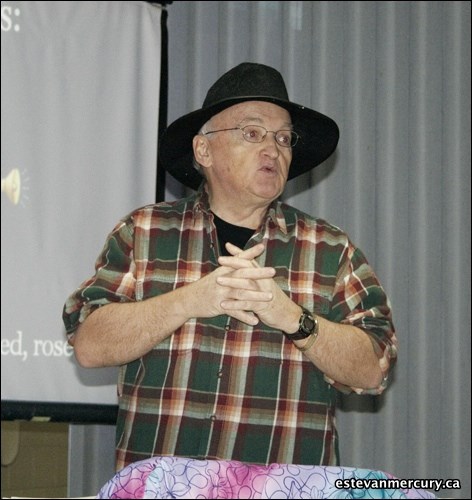A fun information evening was held at the Estevan Public Library on Tuesday with one question on everybody's mind: Who was Robert Burns anyway?
With a meeting room decorated in Scottish flags and books of Burns' poetry, a small group huddled in to learn a bit more about the 18th century bard. Burns Night is coming to Estevan for another year next Saturday, and library program co-ordinator Jill Kergan wanted people who may be going to the event to learn a little bit more about why we celebrate this particular figure.
After a couple of background videos from the BBC were shown, Ron Samoluk took centre stage to share what he knew of the poet. A former teacher who taught a little Burns to his classes each year, Samoluk appeared in a plaid shirt and wide-brimmed hat, adding a little Scottish inflection to his speech when reading from Burns.
"What a fantastic, interesting character," Samoluk said of the poet.
The Scot is so widely adored for his written works because of their accessibility to every man. He is known as the Ploughman's Poet, Samoluk noted. Burns was a farmer himself.
"He was popular because he sat in the bars," he said, so to put it in modern terms, his poems speak to the 99 per cent.
He told the attendees that Burns was a farmer, who spent his off hours in bars imbibing scotch and chasing women.
"He was writing poetry, trying to impress the girls and drinking whisky," said Samoluk. "He loved poetry, he loved whisky and he loved women but not necessarily in that order."
The inspiration for much of his writing was women he was pursuing, whom he regularly named in the pieces. His poems include the names of many women he had spent time with, including the woman he married, Jean Armour. Samoluk noted that Burns did however, have four children with other women, along with nine he had with his wife.
One of Burns' most famous works, Auld Lang Syne, wasn't something he liked to take credit for, said Samoluk, who noted it was based on a traditional Scottish song. Those verses are sung to mark the closing of the previous calendar year by many New Year's revellers.
Other works of Burns that were noted were A Man's a Man for A' That and To a Mouse. The former is a poem about the equality of men, whether they are royalty or farmers. The latter was written after the poet disturbed a mouse nest in his field with a plow. The poem tells of how humans and mice share the same realities of being upended by fate.
After the presentations, the group enjoyed some of the fine fixings of a traditional Burns' supper with haggis, oat cakes and black buns.
For those who wish to hear more about Burns, the Estevan Robbie Burns' Night will be held Jan. 28 at the Legion Memorial Hall with poetry readings, bagpiping and haggis.




